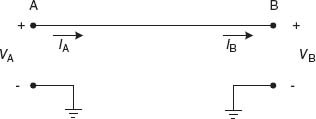9
HOW TO WORK WITH RF SIGNALS
Whether you work with digital circuitry or radio systems, an understanding of radio frequency (RF) signals will enable you to design circuitry that is reliable and manufacturable. RF circuitry is sometimes taught as an elective course only, and you may have missed it. If this applies to you, don’t be intimidated by the strange plots, the number of equations, or the length of this chapter. You will pick up valuable insights and tools—even if it’s your first venture into this fascinating area.
Engineers sometimes make the mistake of designing low-speed (<50 MHz) circuitry without regard to the physical connections between components. For example, given a printed circuit trace between two devices as shown in Figure 9.1, the following assumptions are often made:
Figure 9.1 Connection between two points of a circuit. This notion is useful at low frequencies but doesn’t account for high-frequency effects.

If the physical distance between devices is small compared to the wavelengths1 of the signals involved, these are good assumptions.2 But as frequency increases, these assumptions become less valid, and circuitry doesn’t always work as expected. This can result in ...
Get Ten Essential Skills for Electrical Engineers now with the O’Reilly learning platform.
O’Reilly members experience books, live events, courses curated by job role, and more from O’Reilly and nearly 200 top publishers.

